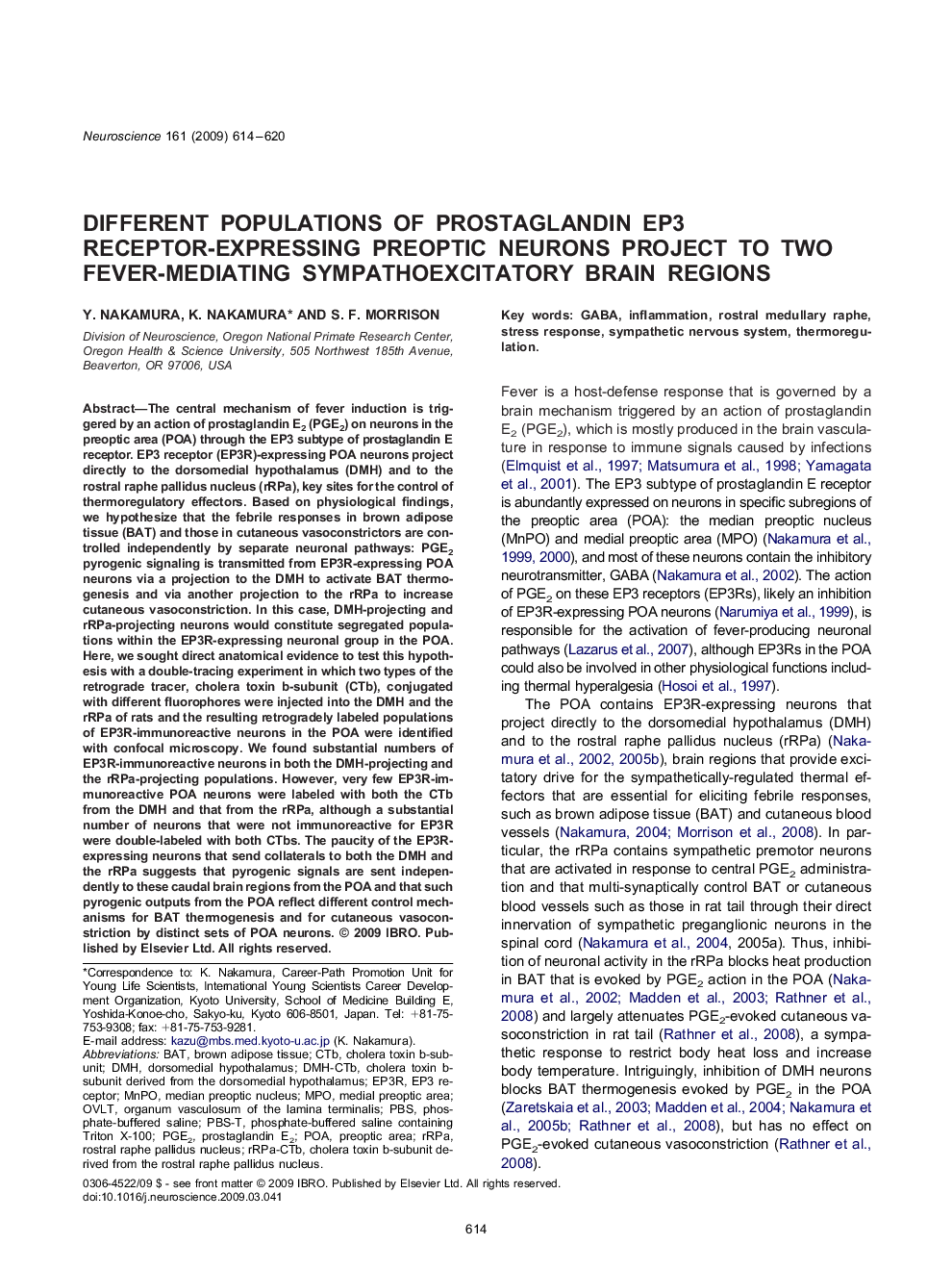| کد مقاله | کد نشریه | سال انتشار | مقاله انگلیسی | نسخه تمام متن |
|---|---|---|---|---|
| 6278229 | 1295800 | 2009 | 7 صفحه PDF | دانلود رایگان |
عنوان انگلیسی مقاله ISI
Different populations of prostaglandin EP3 receptor-expressing preoptic neurons project to two fever-mediating sympathoexcitatory brain regions
دانلود مقاله + سفارش ترجمه
دانلود مقاله ISI انگلیسی
رایگان برای ایرانیان
کلمات کلیدی
phosphate-buffered saline containing Triton X-100POArRPAMNPOCTBDMHPGE2BATOVLTPBSPBS-TMPO - DFOorganum vasculosum of the lamina terminalis - ارگانواسکوئوزوم ترمینال لامیناinflammation - التهاب( توروم) brown adipose tissue - بافت چربی قهوه ایThermoregulation - ترموستات یا دستگاه تنظیم حرارتsympathetic nervous system - سیستم عصبی سمپاتیکPhosphate-buffered saline - محلول نمک فسفات با خاصیت بافریPreoptic area - منطقه Preopticmedial preoptic area - منطقه پیشوپتیک مدیاmedian preoptic nucleus - هسته پیشوپتیک مدیاستdorsomedial hypothalamus - هیپوتالاموس dorsomedialStress response - پاسخ به استرسProstaglandin E2 - پروستاگلاندین E2cholera toxin B-subunit - کلسترول توکسین B-subunitGABA - گاباEP3 receptor - گیرنده EP3
موضوعات مرتبط
علوم زیستی و بیوفناوری
علم عصب شناسی
علوم اعصاب (عمومی)
پیش نمایش صفحه اول مقاله

چکیده انگلیسی
The central mechanism of fever induction is triggered by an action of prostaglandin E2 (PGE2) on neurons in the preoptic area (POA) through the EP3 subtype of prostaglandin E receptor. EP3 receptor (EP3R)-expressing POA neurons project directly to the dorsomedial hypothalamus (DMH) and to the rostral raphe pallidus nucleus (rRPa), key sites for the control of thermoregulatory effectors. Based on physiological findings, we hypothesize that the febrile responses in brown adipose tissue (BAT) and those in cutaneous vasoconstrictors are controlled independently by separate neuronal pathways: PGE2 pyrogenic signaling is transmitted from EP3R-expressing POA neurons via a projection to the DMH to activate BAT thermogenesis and via another projection to the rRPa to increase cutaneous vasoconstriction. In this case, DMH-projecting and rRPa-projecting neurons would constitute segregated populations within the EP3R-expressing neuronal group in the POA. Here, we sought direct anatomical evidence to test this hypothesis with a double-tracing experiment in which two types of the retrograde tracer, cholera toxin b-subunit (CTb), conjugated with different fluorophores were injected into the DMH and the rRPa of rats and the resulting retrogradely labeled populations of EP3R-immunoreactive neurons in the POA were identified with confocal microscopy. We found substantial numbers of EP3R-immunoreactive neurons in both the DMH-projecting and the rRPa-projecting populations. However, very few EP3R-immunoreactive POA neurons were labeled with both the CTb from the DMH and that from the rRPa, although a substantial number of neurons that were not immunoreactive for EP3R were double-labeled with both CTbs. The paucity of the EP3R-expressing neurons that send collaterals to both the DMH and the rRPa suggests that pyrogenic signals are sent independently to these caudal brain regions from the POA and that such pyrogenic outputs from the POA reflect different control mechanisms for BAT thermogenesis and for cutaneous vasoconstriction by distinct sets of POA neurons.
ناشر
Database: Elsevier - ScienceDirect (ساینس دایرکت)
Journal: Neuroscience - Volume 161, Issue 2, 30 June 2009, Pages 614-620
Journal: Neuroscience - Volume 161, Issue 2, 30 June 2009, Pages 614-620
نویسندگان
Y. Nakamura, K. Nakamura, S.F. Morrison,